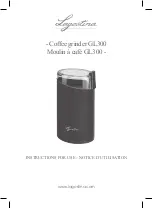
10
ENGLISH (
Original Instructions)
Using grinding wheels
WARNING! Metal powder accumulates.
Excessive use of the grinding wheel on metals
may increase the risk of electric shock. To reduce
the risk, clean the ventilation ducts daily. Follow
the maintenance instructions below to blow dry
compressed air into the ventilation ducts.
Grinding
Surface Grinding with Grinding Wheels
1. Allow the tool to reach full speed before touching the tool
to the work surface.
2. Apply minimum pressure to the work surface, allowing
the tool to operate at high speed. Grinding rate is greatest
when the tool operates at high speed.
3. Maintain a 20˚ to 30˚ angle between the tool and work
surface.
4. Continuously move the tool in a forward and back motion
to avoid creating gouges in the work surface.
5. Remove the tool from work surface before turning tool off.
Allow the tool to stop rotating before laying it down.
Precautions to take when sanding paint
• Sanding of lead based paint is NOT RECOMMENDED
due to the difficulty of controlling the contaminated dust.
The greatest danger of lead poisoning is to children and
pregnant women.
• Since it is difficult to identify whether or not a paint
contains lead without a chemical analysis, we recommend
the following precautions when sanding any paint.
Helpful Hints
• Hold your angle grinder with one hand on the body and
the other hand firmly around the side handle as shown in
Fig. F.
• Always position the guard so that as much of the
exposed disc as possible is pointing away from you. Be
prepared for a stream of sparks when the disc touches the
metal.
• Maintain an angle between the disc and work surface
(Fig.E) of approximately 30° when grinding and 10°- 15°
when sanding for best tool control, material removal, and
minimal loading.Refer to the chart according to particular
function.
CAUTION! Use extra care when grinding into a corner
as a sudden, sharp movement of the grinder may be
experienced when the wheel contacts a secondary surface.
WARNING: Always wear eye protection while
operating this power tool.
Cutting Metal
When cutting, work with moderate feed, adapted to the
material being cut. Do not exert pressure onto the cutting
disc, tilt or oscillate the machine.
Do not reduce the speed of running down cutting discs by
applying sideward pressure.
The machine must always work in an upgrinding motion.
Otherwise, the danger exists of it being pushed uncontrolled
out of the cut.
When cutting profiles and square bar, it is best to start at the
smallest cross section.
MAINTENANCE
Your STANLEY tool has been designed to operate over
a long period of time with a minimum of maintenance.
Continuous satisfactory operation depends upon proper
tool care and regular cleaning.
WARNING! To minimize the danger of serious
personal injury, please switch off the tool power
and disconnect all plugs before adjusting or
removing/ installing any accessory. Before
reassembling the tool, press and release the
trigger switch to make sure the tool is already
switched off.
WARNING! Before performing any maintenance
on corded/ cordless power tools:
Pop-off Brushes
The motor will be automatically shut off indicating that the
carbon brushes are nearly worn out and that the tool needs
servicing. The carbon brushes are not user-serviceable.
Take the tool to an authorised STANLEY repair agent.
Lubrication
STANLEY tools are properly lubricated at the factory and
are ready for use.
Tools should be lubricated regularly every year depending
on usage. (Tools used on heavy duty jobs and tools
exposed to heat may require more frequent lubrication.)
This lubrication should be attempted only by trained power
tool repairperson’s such as those at STANLEY service
centers or in other qualified service personnel.
Cleaning
WARNING! Dust and grit from metal grinding
often accumulate on interior surfaces and could
create an electrical shock hazard if not cleaned
out. Use only mild soap and a damp cloth to
clean the tool. Never let any liquid get inside the
tool; never immerse any part of the tool into a
liquid.
WARNING! Never use solvents or harsh
chemicals to clean non-metal parts of the tool.
These chemicals may weaken the material of
the parts. Use only mild soap and damp cloth
to clean the tool. Never let any liquid get inside
the tool; never immerse any part of the tool into
liquid.
WARNING! Do not overload your angle grinder.
Overloading causes a reduction in speed and
efficiency, causing your angle grinder to become
too hot. If this happens, operate your angle
grinder under no load for one or two minutes until
it has cooled to normal operating temperature.
Switching your angle grinder off under load will
reduce the life of the switch.
IMPORTANT! To ensure product SAFETY
and RELIABILITY, repairs, maintenance and
adjustment (other than those listed in this
manual) should be performed by authorized
Summary of Contents for STGS9115
Page 1: ...STGS9115 STGS9125 English Page 04 Russian Page 13 Ukrainian Page 25 Turkish Page 36 ...
Page 2: ...2 ENGLISH Original Instructions n A B C 1 11 3 2 8 7 6 4 5 3 10 12 9 ...
Page 45: ......
Page 46: ......
Page 47: ......
Page 48: ...N845882 09 2020 ...











































